Cree SMD Blue-Green LED
(Rec'd in early 2003, tested 12-05-04, spectrographic analysis performed 11-16-06x)
A fan of the website send me this LED in early-2003, already affixed to a piece of breadboard and outfitted with a resistor, reverse-polarity protection diode, and a 9V battery connector. I somehow managed to lose or misplace it, but it turned up on 11-18-04 while I was looking through boxes following a move I made on 10-11-04.
Here are a couple of photographs:
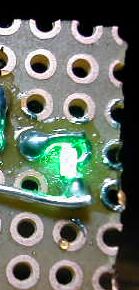
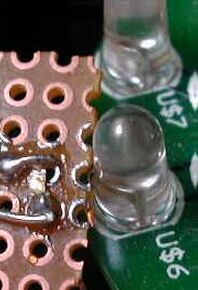
The photograph on the left shows the LED illuminated, and the one on the right shows it compared in size to a 5mm through-hole LED.
Tested on a Duracell 9 volt battery that measures 8.28 volts open-circuit.
The approximate dominant wavelength (where you would point to on a colour chart) is 507nm, which is considered to be "traffic signal green".
The sender of this LED wrote the following:
I got it from ETG. Model unknown. The die sure looks like a Cree - unknown series. Size I believe 0603. Possibly in ETG's website, or possibly an older version of something in their website...
Look at: http://www.etgtech.com/pdf/ETG-0603.pdf.
It may be an ETG-0603CE505-130 or some older version with a similar part number.
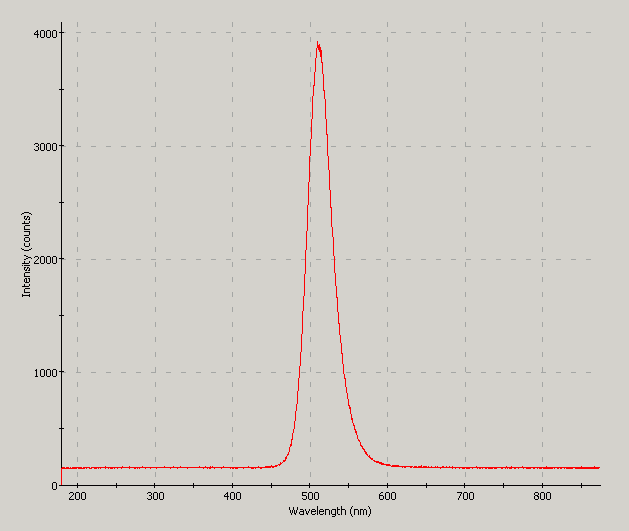
Spectrographic analysis of this LED.
Ocean Optics USB2000 Spectrometer on loan from TWO-CUBED.
Manufacturer unknown
Received 07-03-04, tested 07-04-04
A fan of the website (J.R. in Michigan) sent 11 LEDs (thank you!!!
 ), and three of these white SMD LEDs were among the goods. I don't know who makes the die (light-emitting chip) inside this LED, and I don't know the size, so please do not ask, thank you.
), and three of these white SMD LEDs were among the goods. I don't know who makes the die (light-emitting chip) inside this LED, and I don't know the size, so please do not ask, thank you.This is a phosphor white LED. The working chemistry is probably GaN (gallium nitride), single-bond construction, on a SiC (silicon carbide) substrate. If it really is a single-bond type chip, Cree Corp. could be the manufacturer.
These LEDs came to me already mounted on header connections, so I did not have any problems measuring and examining them while they were illuminated.
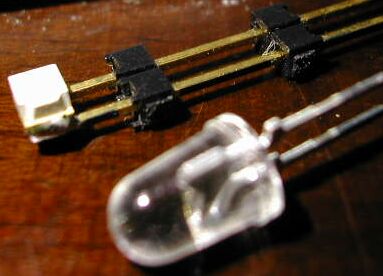
I cannot obtain a beam photograph at the correct distance, so I photographed the LED itself next to a standard 5mm LED. This LED is the one closer to the top of the photograph.
This LED appears to have a wide viewing angle beam of approximately 100 degrees; since I do not have the equipment for measuring viewing angles, this is an eyeballed value. Brightness is on the low end, but it DID register on my Meterman LM631 light meter at 541mcd.
Remember, wider viewing angles always mean fewer mcds.
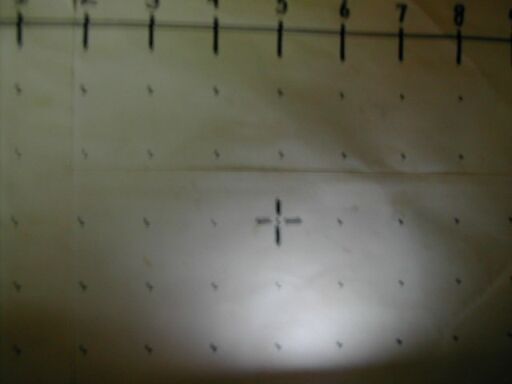
Here's a photograph showing the LED at the base of the test target, aiming at the ceiling.
This should give you some indication of the LED's viewing angle.
Osram, part # LW W5SG, SMD, 120°
(Received on 04-16-04, found on 04-22-04, tested on 04-25-04)
This is the much talked about "Golden Dragon" 1-watt white LED from Osram. Although this is an SMD LED, there is a circular metal plate or slug on the bottom to help heatsink it, and two metal tabs are present on the LED's sides for connection purposes.
There is a red LED inside wired "anti parallel" to the main chip, both to help protect the main chip and to indicate a reverse polarity condition.
The Golden Dragon is rated for a drive current of 350mA. There is no figure provided for Vf (forward voltage). Figure it to be 3.6 to 3.8 volts DC at a 350mA drive current.
Ehhhh, doodlebugs!!! :-(
Son of a diddly!!!
I normally don't handle SMD components here, and this is exactly why...the @%#&ing thing came off the test clip I had just attached to it for metering purposes and to obtain a beam photograph, and flew who knows where. :-(
If I find the Golden Dragon, I'll resume this page...if not, then it looks like we're SOL.
Update 04-23-04: I found the Golden Dragon LED late last night, so I'll resume testing as soon as I can.
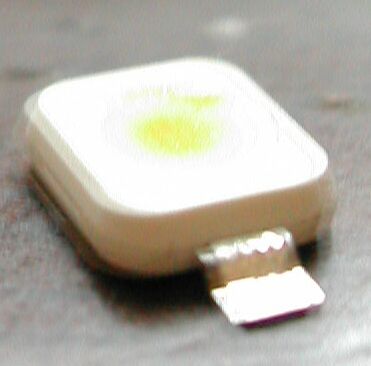
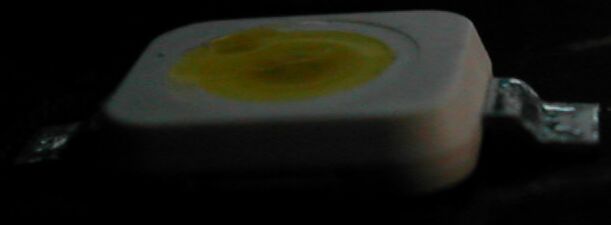
I soldered leads to the Golden Dragon, so I should not lose it again...well, not this way anyway.

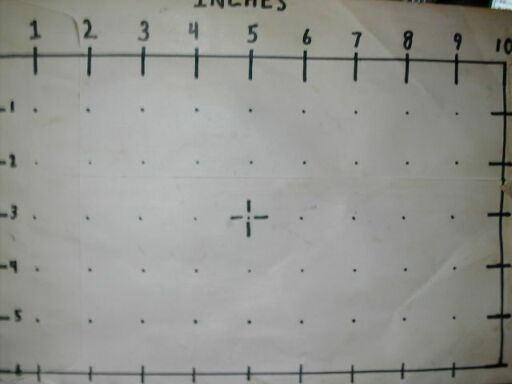
Test current is 0.354 amps (354mA).
The published viewing angle is 120°, which is too wide for me to get a good intensity reading with the instruments at my disposal.
The color temperature of this LED appears to be approximately 6,500°K to 7,000°K. This is a cool, pure white color. There are no hints of yellow, blue, violet, or "rotten cat urine green" anywhere in this LED's beam. The beam is very smooth, with no rings, dark blotches, or other irregularities in it.
Nichia America, part # NCCW022, SMD, 70°
(Received and tested 03-17-04)
This is Nichia's latest LED to show up in the high-powered LED wars. This is labelled as a SMD LED, even though it seems large for an SMD component. But it has a flat base with the leads going off to the sides, so it can indeed sit flush on a PCB or what have you.

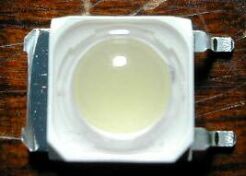
Here are a couple of pictures, showing the new LED both at an isometric angle and from above.
The web page referencing these new LEDs is http://www.nichia.co.jp/product/led-smd-powerled.htm if you're interested.

This LED is rated to deliver 23 lumens of light, however I cannot measure lumens because you need a special instrument called an "integrating sphere" to do that, and I don't own or have access to one. And readings in mcd (millicandelas) will seem awfully low, because this LED has a wide viewing angle of 70°. If the beam were focused with an optic or a lens, values above 200,000mcd aren't unreasonable.
The Vf of this LED can range from 3.8 to 4.3 volts DC, and you're supposed to supply 350mA to it - 500mA maximum - with proper heatsinking of course.
A flashlight using this LED was supplied with the LED itself, and it has a bright, surprisingly wide beam, even though it's focused with an aspherical lens. The link to this flashlight is right here if you're interested.
The LED itself is very new, and I don't believe it is on the Nichia website or the Nichia Light Emitting Diode 2004 catalogue yet.
Panasonic, SMD red, size 0402, model # LNJ219R9ARA,
price 75¢ each for <10 from Digikey
(Digi Key part number P592TR-ND)
Added to the site 10-19-03
A fan of the website sent me one of these, already soldered to a board, resistored, and ready to plug into a 9v battery. He also sent a second one with thin wire leads soldered to it. They are very, very tiny; so small you could easily blow them away when setting up for a photograph shoot, soldering them to a board, or soldering wire leads to them. One little sneeze is all it would take to blow a hundred or more of these things into the rug, where they would likely then fall prey to the hungry, hungry vaccume cleaner. :-\

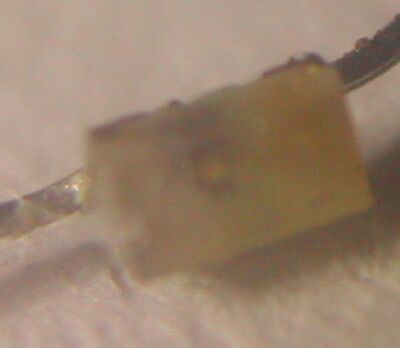
See how TINY that thing is?
The left-hand picture shows one mounted to a piece of perfboard.
The right-hand picture shows one on paper with thin wire leads soldered to it.
These LEDs are barely larger than a grain of sugar or salt.
The color appears to be right around 640nm in the red part of the spectrum. My spectroscope is broken, so I can't get a totally accurate fix on it. To the eye though, it appears to radiate mainly near 640nm. Brightness isn't high, but it's relatively decent. Because this is a lensless SMD component, I can't get an accurate figure on this either May be too low for my light meter to resolve. But wider viewing angles always mean fewer mcd, regardless of the LED die type.
Current draw on the pre-resistored test sample is 9.6 milliamps when connected to a virtually new Radio Shack Enercell Plus 9 volt battery (open circuit voltage 9.53 volts, dropping just to 9.48 volts when this LED is connected).
From the person who supplied these: According to the mechanical drawing in the Digi-Key catalog, these Panasonic 0402 LEDs are 1 mm long, .5 mm wide, .35 mm thick (in inches approx. .04 by .02 by .014).
470nm blue SMD (0603), International Systems Processing (ISP Korea), $TBA
If you like your LEDs tiny, you'll love these.
Packaged in a 0603 SMD case, this blue LED from ISP Korea isn't for everyone, and here's why:
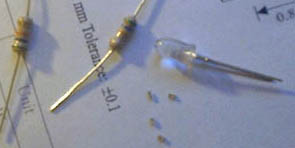
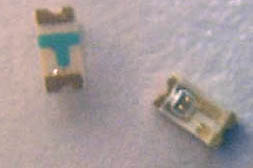
Left: ISP's blue LED compared with an ordinary 5mm LED and some 1/4 watt resistors.
Right: Close-up showing two of these. The one on the left is upside-down.
This amazingly miniscule LED measures just 800 microns wide by 1,000 microns long. It uses traditional InGaN on artificial sapphire technology, so it should be very bright for its size. And herein lies the problem: how to test one of these. Trying to light this LED with the equipment I have is like trying to thread a needle with boxing gloves on. I actually lost one while shooting these pictures; thanks Mr. Chang for sending several, I may need them all before this is done! :)
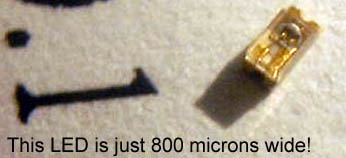
Close-up of one. You can see the actual die and the two bond wires inside the clear encapsulant.
The type on the paper is about the size you see in newspaper text.
Here are the published specs:
Forward voltage: 3.6 volts typical, 4.5 volts max.
Forward current: 30mA continuous maximum, 100mA pulsed maximum (10uS pulse, 10% duty cycle)
Luminous intensity: 55mcd typical (remember, wider view angles mean lower mcd numbers)
Viewing angle: 120°
Spectral line halfwidth: 20nm
Dominant wavelength: 470nm
Size specifications (SMD 0603)
Length: 1.6mm
Width: 0.8mm
Height: 0.8mm
Solder pads: 0.4mm x 0.7mm
Spacing between solder pads: 0.8mm
In order to actually connect one of these, I'm going to have to make a jig of some kind. Ordinary micro clips are downright gargantuan when compared to this LED, and a test hookup using component leads clipped into the test set was unsuccessful, as the leads were still too large to manipulate into position. The next attempt will be made with sewing needles under a 100x microscope... now where did I put Grandma's sewing kit...???
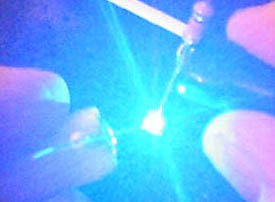
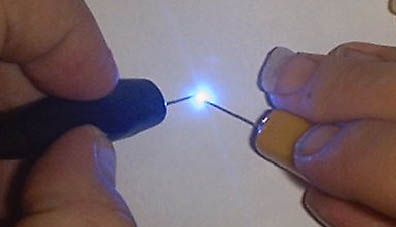
Left: Photo taken without flash.
Right: Photo taken with flash.
As near-point sources, these guys are pretty darned bright. Taking measurements will be a bit of a problem though, as I need both hands to manipulate the test probes into position; I'd need two more hands to hold the sensor in place over the LED and manipulate the photometer's console. :-O
I have since gotten several different SMDs soldered to wires, and I'll have pictures & measurements (if possible) in the near future.
WHITE 5500-6500K InGaN+phosphor ULTRAVIOLET 370-390nm GaN BLUE 430nm GaN+SiC BLUE 450 and 473nm InGaN BLUE Silicon Carbide TURQUOISE 495-505nm InGaN GREEN 525nm InGaN YELLOW-GREEN 555-575mn GaAsP & related YELLOW 585-595nm AMBER 595-605nm ORANGE 605-620nm ORANGISH-RED 620-635nm RED 640-700nm INFRARED 700-1300nm True RGB Full Color LED Spider (Pirrahna) LEDs SMD LEDs True violet (400-418nm) LEDs Agilent Barracuda & Prometheus LEDs Oddball & Miscellaneous LEDs Programmable RGB LED modules / fixtures Where to buy these LEDs Links to other LED-related websites The World's First Virtual LED Museum The Punishment Zone - Where Flashlights Go to Die Legal horse puckey, etc. RETURN TO OPENING/MAIN PAGELEDSaurus (on-site LED Mini Mart)
This page is a frame from a website.
If you arrived on this page through an outside link,you can get the "full meal deal" by clicking here.